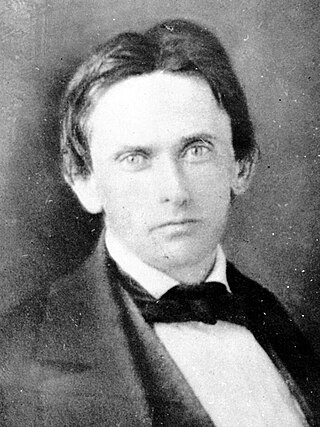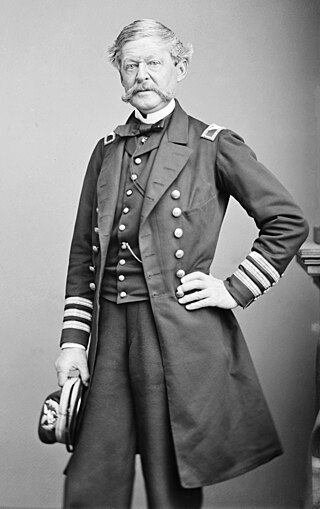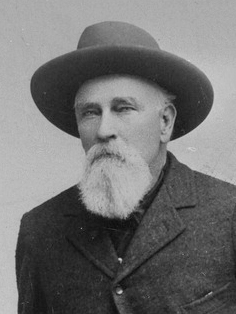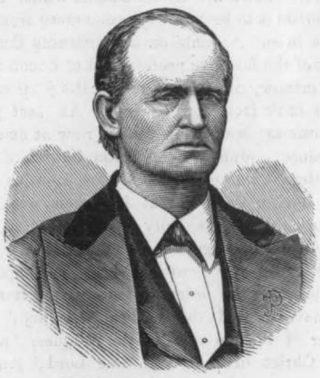
James Oliver Van de Velde was a U.S. Catholic bishop born in Belgium. He served as the second Roman Catholic Bishop of Chicago between 1849 and 1853. He traveled to Rome in 1852 and petitioned the Pope for a transfer to a warmer climate, due to his health. In 1853, the transfer was granted; Van de Velde became bishop of the Diocese of Natchez, in Mississippi, where he served until his death two years later.

Kelley Park is a 156-acre (63 ha) city park in San Jose, California, United States.

Joshua Abraham Norton was a resident of San Francisco, California, who in 1859 declared himself "Emperor of these United States" in a proclamation that he signed "Norton I., Emperor of the United States". Commonly known as Emperor Norton, he took the secondary title "Protector of Mexico" in 1866.
Jesse Wilbur Ames, also known as Juliano Ames, was a San Diego pioneer. He was born in Amesbury, Massachusetts but arrived as a sailor in San Diego in 1820, from Plainfield, Connecticut.

Peter Donahue, was an Irish American businessman and Industrial pioneer. He and his brothers James and Michael are considered the founders of industrial San Francisco. Born in Glasgow, Scotland of Northern Irish parents, his family moved to Paterson, New Jersey when he and his brothers were young. It was there that they learned the trade of machinists.
Louis James Balbach was an American diver who won a bronze medal in the 1920 Summer Olympics.
Visalia, California, commonly known in the 1850s as Four Creeks, is the oldest continuously inhabited inland European settlement between Stockton and Los Angeles. The city played an important role in the American colonization of the San Joaquin Valley as the county seat of Old Tulare County, an expansive region comprising most if not all of modern-day Fresno, Kings, and Kern counties.

Rancho Campo de los Franceses was a 48,747-acre (197.27 km2) Mexican land grant in present-day San Joaquin County, California given in 1844 by Governor Manuel Micheltorena to Guillermo Gulnac. "Campo de los Franceses” which in English means “French Camp” refers to French-Canadian fur trappers who wintered there. The grant included present-day French Camp and Stockton.

Benjamin Ignatius Hayes was an American pioneer who was the first judge of the district court that served Los Angeles, San Diego and San Bernardino counties in California. His seminal rulings are still cited in that state's courts.

Cadwalader Ringgold was an officer in the United States Navy who served in the United States Exploring Expedition, later headed an expedition to the Northwest and, after initially retiring, returned to service during the Civil War.

Parker Hardin French was an adventurer, entrepreneur, and swindler, labeled and chronicled by author Joe Goodbody as the “Kentucky Barracuda.” As a runaway child he fought as a member of the Royal Navy in the First Opium War as a cabin boy and a "powder monkey". At only 22, he was a commission merchant and a year later built the first ocean going ship on the upper Mississippi. Before he was 30, he was the leader of an infamous and fraudulent gold rush expedition; implicated in an irregular invasion of Cuba; jailed bandit and then military hero in Mexico; lawyer, district attorney, legislator, journalist, and political enforcer in California; he was a real estate developer; lawyer; journalist; part of a conspiracy to invade Mexico; suspected seditionist agitator and Confederate agent; jailed as a political prisoner; and lawyer and purveyor for Union troops. His final days were spent in obscurity but the period was still peppered with the occasional swindle that garnered both regional and national attention. When French died in 1878, his death went generally unnoticed. Newspapers had reported the death of French before—at least five separate times. He had been twice killed in gunfights, twice executed in Mexico—once by a firing squad, once by hanging—and once killed in Nicaragua. Acquaintances thought he might have drunk himself to death. For a while, there was a lapse of interesting press reports, so many just presumed that he was already dead and were surprised when he was not. Some pondered his many misadventures and wondered how he escaped retribution from a hangman, a firing squad, or an irate victim. Though a notorious scoundrel in his time, notably from 1850 to 1862, French has been relegated to a minor footnote in antebellum America and Civil War history.
William Taylor Barnes Sanford (1814–1863) was an American road builder, a landowner and the second postmaster of Los Angeles, California, after it became a part of the United States. He was a member of the Los Angeles Common Council from 1853 to 1854.
John Goller was an American pioneer and the first blacksmith in Los Angeles, California. He owned a blacksmith and carriage-making business and was a member of the governing body of Los Angeles as well as a founder of the city's first gas company.
Louis Roeder (1835–1915) was a member of the governing body of Los Angeles, California, in the 19th century, who rose from being a pioneer blacksmith and carriage maker to one of the wealthiest landowners in the city.

Fenton Mercer Eurice Slaughter was an American soldier, pioneer, gold miner, mechanical engineer, farmer and politician. After serving in the Mexican-American War, he spent most of the rest of his life in California, where he became a successful farmer and politician.

Elihu Anthony was an American alcalde, blacksmith, industrialist, abolitionist, postmaster, and minister. He is considered a founding father of the city of Santa Cruz. He also served as a member of the California State Assembly 6th District, 1880–1881. He was active within the anti-Chinese movement, but paradoxically he had also supported abolitionism.

Sarah L. Knox-Goodrich was a women's rights activist who worked for women's suffrage in California in the late nineteenth century. Her first husband, William Knox, was a business man, banker, and state politician. Her second husband, Levi Goodrich, was an architect in Southern California. Knox-Goodrich used her wealth and her social position to push for equal employment, school suffrage, and voting rights.

Francis Doud was a California pioneer of 1849, a veteran soldier of the Mexican–American War, who enlisted in the army "to fight the Indians". He established the Doud House in ca. 1852, and acquired 5,000 acres (2,000 ha) along the seacoast south of Monterey, California, in 1891 to create the Doud Ranch. He was known as a "prominent capitalist".












